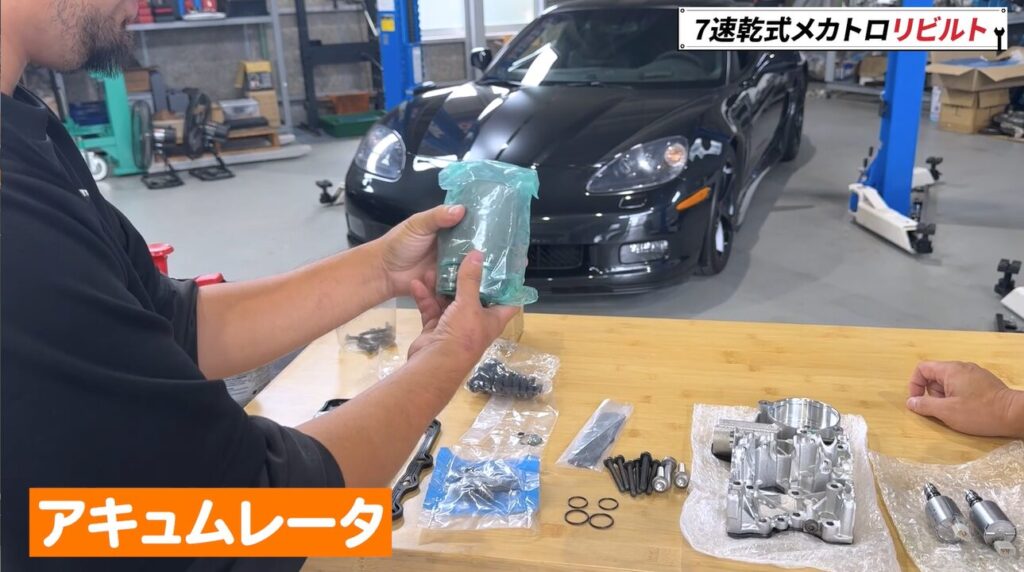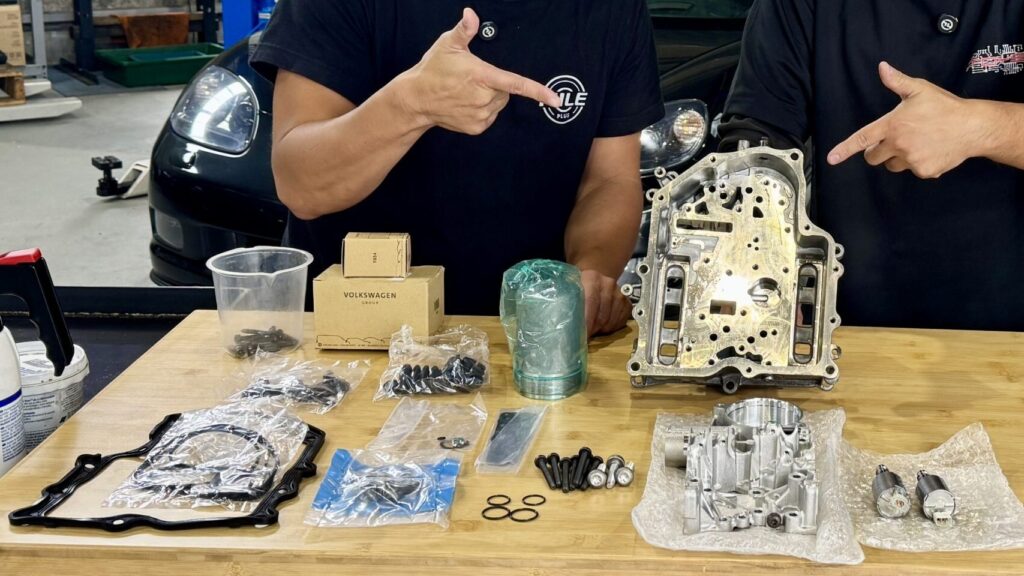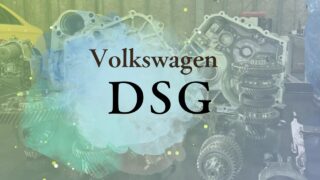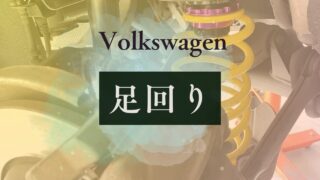Accumulator Recall Explained—Root Causes & Fixes
Volkswagen and Audi’s 7-speed dry DSG (code: DQ200) delivers the snappy shifts people love in a dual-clutch. At the same time, it has a reputation for frequent mechatronics issues.
The mechatronics is the electro-hydraulic control unit that integrates the clutch and shift control. Inside are a hydraulic pump, accumulator, solenoid pack, and an ECU (control board)—multiple precision parts in one compact housing.
In this teardown-based explainer, we cover:
Reference: Nile Mecha Channel “DQ200 Mechatronics teardown & recall cause explained.”
If you’re new to DSG, start here:
👉 DSG Basics — Dry vs Wet, judder countermeasures, fluid service, and mechatronics repair overview
- What “Mechatronics” Means on the 7-Speed Dry DSG (DQ200)
- Why the DQ200 Is Seen as “Fragile”: Design Risks & Real-world Stress
- How Accumulators Crack + What the Recall Did
- Inside the Unit: Key Parts & Functions
- ECU Generations & Repair Notes (Compatibility / Learned Values / Adaptation)
- Critical Workshop Points (for Technicians)
- Design Updates & Late-model Improvements
- Repair/Replace Options: In-house Repair vs Rebuilt vs Full ASSY
- How to Drive & Maintain for Longevity
- Keeping a Dry DQ200 Healthy for the Long Run
- FAQ
What “Mechatronics” Means on the 7-Speed Dry DSG (DQ200)

What the unit actually does
The DQ200’s mechatronics blends hydraulics (“mecha”) and electronic control (“tronics”)—it’s both the brain and the heart of the transmission. It converts driver inputs into hydraulic actions that engage clutches and select gears, in real time.
The four core elements
| Component | Role |
|---|---|
| Hydraulic pump | Builds working pressure for shifts and clutch control |
| Solenoid pack | Switches oil flow to actuate clutches and forks |
| ECU (control board) | Interprets driver/engine data and commands pressure |
| Accumulator | Stores pressure for fast, stable shifts |
Typical symptoms when it fails
- Wrench/gear warning on the cluster
- Select D/R but the car doesn’t move
- Shift shock, gear drop-out, “Transmission malfunction” message
Because this unit coordinates everything, mechatronics failure often looks like “the whole DSG is broken.”
Why the DQ200 Is Seen as “Fragile”: Design Risks & Real-world Stress
- Compact & lightweight: great for efficiency, tight margins for heat and pressure.
- Early plastic accumulator housing: light and cheap, but ages quickly under heat/pressure → micro-cracks → leaks → pressure loss.
- Japanese operating environment: hot/humid summers + stop-and-go traffic elevate oil temps; elastomers swell/harden.
- Constant high pressure: around 60 bar (~6000 kPa) in the circuit; superb shift response, but high stress on the accumulator.
- Quiet aging: O-rings and gaskets harden over time; small leaks reduce pressure response → judder/lag at launch.
Result: the DQ200 can be sensitive to heat, pressure, and age, especially in congested urban use.
How Accumulators Crack + What the Recall Did

What the accumulator is
A small pressure reservoir that stores pump pressure and releases it instantly for gear/clutch actions—think of it as a hydraulic battery. It uses nitrogen gas to buffer pressure, and in the DQ200 sees ~60 bar regularly.
Why it cracked
Early DQ200s (e.g., Golf 6/early Beetle) used a plastic housing. Long-term heat and pressure slowly embrittle the plastic, growing micro-cracks until it fails with a pop. Pressure collapses, and the car may no longer move in D/R.
The recall
From around 2013, VW issued a global recall to replace the accumulator assembly with a reinforced design (metal sleeve/strengthened housing) and, in some cases, to revise pressure control logic. Europe also saw sleeve-type repair kits; in Japan, full replacement with the countermeasure part is standard.
The fix largely eliminated housing cracks—but age, heat, and poor fluid management can still create other hydraulic issues over time.
Inside the Unit: Key Parts & Functions

| Section | Function | Common Issues |
|---|---|---|
| Electric oil pump | Builds line pressure | Motor burnout, low pressure |
| Accumulator | Stabilizes/temporarily stores pressure | Housing crack, oil leak |
| ECU board | “Brain” that commands pressure | Heat aging, oil ingress, corrosion |
| Solenoid pack | Switches flow for shift/clutch actions | Sticking, electrical faults |
| Internal filter | Traps debris | Clogs (non-serviceable) |
Design note: Hydraulics and ECU share one tight case (space/response win), but that raises stakes for cooling and sealing; heat and micro-leaks can reach the ECU.
Fluid quality & temperature control directly affect solenoid/pump life—regular fluid service matters.

Related reads:
- DSG fluid service — timing and benefits explained
- Costs & effects of 7-speed wet DSG fluid service
- Is the dry 7-speed really “lifetime fill”?
- Hands-on: servicing the 6-speed wet DSG fluid
ECU Generations & Repair Notes (Compatibility / Learned Values / Adaptation)
The ECU is the mechatronics control brain. It monitors pressure, temperature, and clutch position, and commands the solenoids.
| Model/Generation | ECU Feature | Repair/Swap Notes |
|---|---|---|
| Golf 6 / 6R / early Beetle | No immobilizer tie-in on the mechatronics ECU | Used unit can be reused with adaptation only |
| Golf 7 → | Immobilizer integrated into mechatronics | Direct swap won’t work. Move your board or re-program/clone data |
When ECUs fail: warnings, D/R won’t engage, communication faults. Root causes include heat-related solder cracks, oil ingress, and aging of communication paths.
Costs (typical): in-house ECU/mechatronics repair ¥150k–¥250k; Golf 7→ with immobilizer work can approach ¥300k.
Critical Workshop Points (for Technicians)
- Accumulator is loosened on-car first: very tight; loosen before dropping the unit to avoid case damage.
- Case bolts & lengths: map positions; a few millimeters can pinch internals. Replace gaskets—don’t reuse.
- Check balls (x3): tiny and easy to lose; store with a magnetic tray; don’t mix L/R-specific gaskets.
- Internal filter is non-serviceable: only prevention is timely fluid changes.
- Torque/angle discipline & cleanliness: over-tightening can bind solenoids/pump. Treat as precision machinery, not a generic AT.
DIY is unsafe—use a VW/Audi specialist.
Design Updates & Late-model Improvements
| Area | Update | Effect |
|---|---|---|
| Accumulator | Plastic → metal-sleeved/reinforced housing | Much higher heat/pressure resistance |
| Pump motor | Thermal measures | Stable in long congestion |
| Forks | Bearing → sleeve-type revisions | Less wear/stickiness |
| ECU control | Softer peak pressure control | Lower accumulator stress |
| O-rings/gaskets | Higher-temp elastomers | Less seep/aging |
Golf 7/7.5 also improved thermal layout and control logic; mechatronics-specific recalls are now rare. Field reports show “it lasts long if fluid care is done.”
Even so, it’s still a high-pressure, high-temp module—fluid care remains essential (every 40–50k km in practice).
Repair/Replace Options: In-house Repair vs Rebuilt vs Full ASSY
| Method | What happens | Typical Cost (tax incl.) | Lead Time | Notes |
|---|---|---|---|---|
| New OEM | Brand-new countermeasure unit | ¥350k–¥450k | Same day–few days | Highest assurance; pricey |
| Used swap | Used unit from another car | ¥200k–¥300k | 1–2 weeks | Quality varies; Golf 7→ needs board move/program |
| In-house repair | Tear-down, replace/refresh (accumulator, O-rings, solenoids, ECU repair) | ¥150k–¥250k | 2–3 weeks | Best value for localized faults |
Rule of thumb
- Newer car/long ownership horizon → New
- 10+ years/keep costs down → In-house repair
- Have a donor unit and proper programming → Used (with caution)
Whatever you choose, perform adaptation (DSG relearn) or you’ll retain shocks and pressure errors.
How to Drive & Maintain for Longevity
- In traffic: avoid endless creep. After ~10 minutes, shift to N to rest the pump and reduce heat.
- On hills: apply the parking brake before selecting P to unload the lock and forks.
- Shut-down sequence: brake → parking brake → wait for body to settle → P → engine OFF.
- Fluid service: practical interval 40–50k km. Use the correct VW spec (e.g., G 052 512 A2 or equivalent). Replace crush washers/O-rings.
- Daily checks: look for oil weep under the car, watch for flare/shock, and heed wrench/gear warnings.
Small habits dramatically cut heat/pressure stress and extend life.
Keeping a Dry DQ200 Healthy for the Long Run
If you drive an early DQ200 (Golf 6/early Beetle), consider a specialist inspection and, if needed, upgraded/countermeasure parts or a quality rebuilt unit.
Handled well, a DQ200 can run smoothly for many years.
FAQ
Q1. Mechatronics vs “transmission”: what’s the difference?
Mechatronics = brain/heart (electro-hydraulic control). Transmission “case” = gears/shafts. Often the control fails while gearsets remain fine.
Q2. How do I spot a cracked accumulator?
Oil leaks and a wrench light are typical. Pressure drops → D/R won’t move the car. Stop and have a specialist check it.
Q3. Will it fail again after replacement?
With the reinforced accumulator, that failure is unlikely. Other parts still age—keep up fluid care and temperature management.
Q4. Do I need programming after replacement?
Yes. Adaptations/relearns are mandatory to set clutch kiss points and hydraulic responses.
Q5. DIY fluid change on the dry 7-speed?
Not recommended. Small errors in quantity/temperature control can upset pressure balance and harm components.
Q6. Typical costs?
- New mechatronics: ¥350k–¥450k
- In-house repair (rebuild): ¥150k–¥250k
- DSG fluid service: ¥15k–¥25k
Notice:
This guide summarizes general structure and recall information for the 7-speed dry DSG (DQ200) mechatronics. Actual disassembly requires special tools, diagnostics, and adaptation. Always use a VW/Audi specialist.





-2.jpg)
-1-120x68.jpg)

コメント